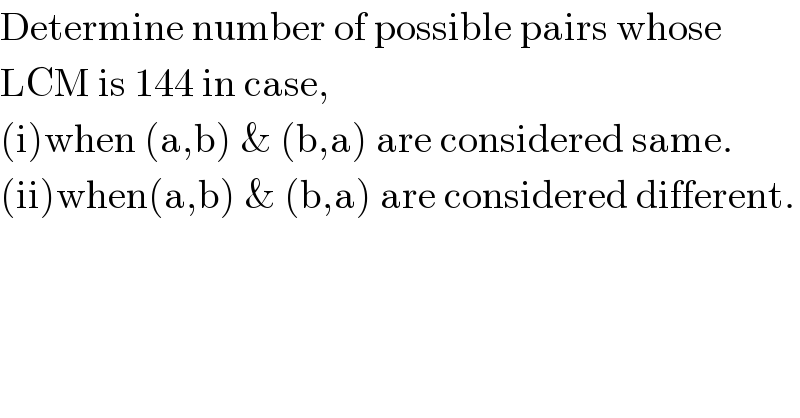
Question Number 34358 by Rasheed.Sindhi last updated on 05/May/18

$$\mathrm{Determine}\:\mathrm{number}\:\mathrm{of}\:\mathrm{possible}\:\mathrm{pairs}\:\mathrm{whose} \\ $$ $$\mathrm{LCM}\:\mathrm{is}\:\mathrm{144}\:\mathrm{in}\:\mathrm{case}, \\ $$ $$\left(\mathrm{i}\right)\mathrm{when}\:\left(\mathrm{a},\mathrm{b}\right)\:\&\:\left(\mathrm{b},\mathrm{a}\right)\:\mathrm{are}\:\mathrm{considered}\:\mathrm{same}. \\ $$ $$\left(\mathrm{ii}\right)\mathrm{when}\left(\mathrm{a},\mathrm{b}\right)\:\&\:\left(\mathrm{b},\mathrm{a}\right)\:\mathrm{are}\:\mathrm{considered}\:\mathrm{different}. \\ $$
Commented bycandre last updated on 05/May/18
![144=72×2=36×2^2 =18×2^3 =9×2^4 =2^4 ×3^2 S={x∈N;x∣144} S={1,2,3,4,6,8,9,12,16,18,24,36,48,72,144} ∣S∣=5×3=15 [(1,3,9),(2,6,(18)),(4,(12),(36)),(8,(24),(72)),((16),(48),(144)) ]](Q34364.png)
$$\mathrm{144}=\mathrm{72}×\mathrm{2}=\mathrm{36}×\mathrm{2}^{\mathrm{2}} =\mathrm{18}×\mathrm{2}^{\mathrm{3}} =\mathrm{9}×\mathrm{2}^{\mathrm{4}} =\mathrm{2}^{\mathrm{4}} ×\mathrm{3}^{\mathrm{2}} \\ $$ $${S}=\left\{{x}\in\mathbb{N};{x}\mid\mathrm{144}\right\} \\ $$ $${S}=\left\{\mathrm{1},\mathrm{2},\mathrm{3},\mathrm{4},\mathrm{6},\mathrm{8},\mathrm{9},\mathrm{12},\mathrm{16},\mathrm{18},\mathrm{24},\mathrm{36},\mathrm{48},\mathrm{72},\mathrm{144}\right\} \\ $$ $$\mid{S}\mid=\mathrm{5}×\mathrm{3}=\mathrm{15} \\ $$ $$\begin{bmatrix}{\mathrm{1}}&{\mathrm{3}}&{\mathrm{9}}\\{\mathrm{2}}&{\mathrm{6}}&{\mathrm{18}}\\{\mathrm{4}}&{\mathrm{12}}&{\mathrm{36}}\\{\mathrm{8}}&{\mathrm{24}}&{\mathrm{72}}\\{\mathrm{16}}&{\mathrm{48}}&{\mathrm{144}}\end{bmatrix} \\ $$
Answered by MJS last updated on 05/May/18

$$\left(\mathrm{1};\mathrm{144}\right) \\ $$ $$\left(\mathrm{2};\mathrm{144}\right) \\ $$ $$\left(\mathrm{3};\mathrm{144}\right) \\ $$ $$\left(\mathrm{4};\mathrm{144}\right) \\ $$ $$\left(\mathrm{6};\mathrm{144}\right) \\ $$ $$\left(\mathrm{8};\mathrm{144}\right) \\ $$ $$\left(\mathrm{9};\mathrm{144}\right)\:\left(\mathrm{9};\mathrm{16}\right)\:\left(\mathrm{9};\mathrm{48}\right) \\ $$ $$\left(\mathrm{12};\mathrm{144}\right) \\ $$ $$\left(\mathrm{16};\mathrm{144}\right)\:\left(\mathrm{16};\mathrm{18}\right)\:\left(\mathrm{16};\mathrm{36}\right)\:\left(\mathrm{16};\mathrm{72}\right) \\ $$ $$\left(\mathrm{18};\mathrm{144}\right)\:\left(\mathrm{18};\mathrm{48}\right) \\ $$ $$\left(\mathrm{24};\mathrm{144}\right) \\ $$ $$\left(\mathrm{36};\mathrm{144}\right)\:\left(\mathrm{36};\mathrm{48}\right) \\ $$ $$\left(\mathrm{48};\mathrm{144}\right)\:\left(\mathrm{48};\mathrm{72}\right) \\ $$ $$\left(\mathrm{72};\mathrm{144}\right) \\ $$ $$\left(\mathrm{144};\mathrm{144}\right) \\ $$ $$ \\ $$ $$\left(\mathrm{i}\right)\:\mathrm{23} \\ $$ $$\left(\mathrm{ii}\right)\:\mathrm{45} \\ $$
Commented byRasheed.Sindhi last updated on 05/May/18
ŦΉΛПKS Λ LӨŦ SIЯ!
